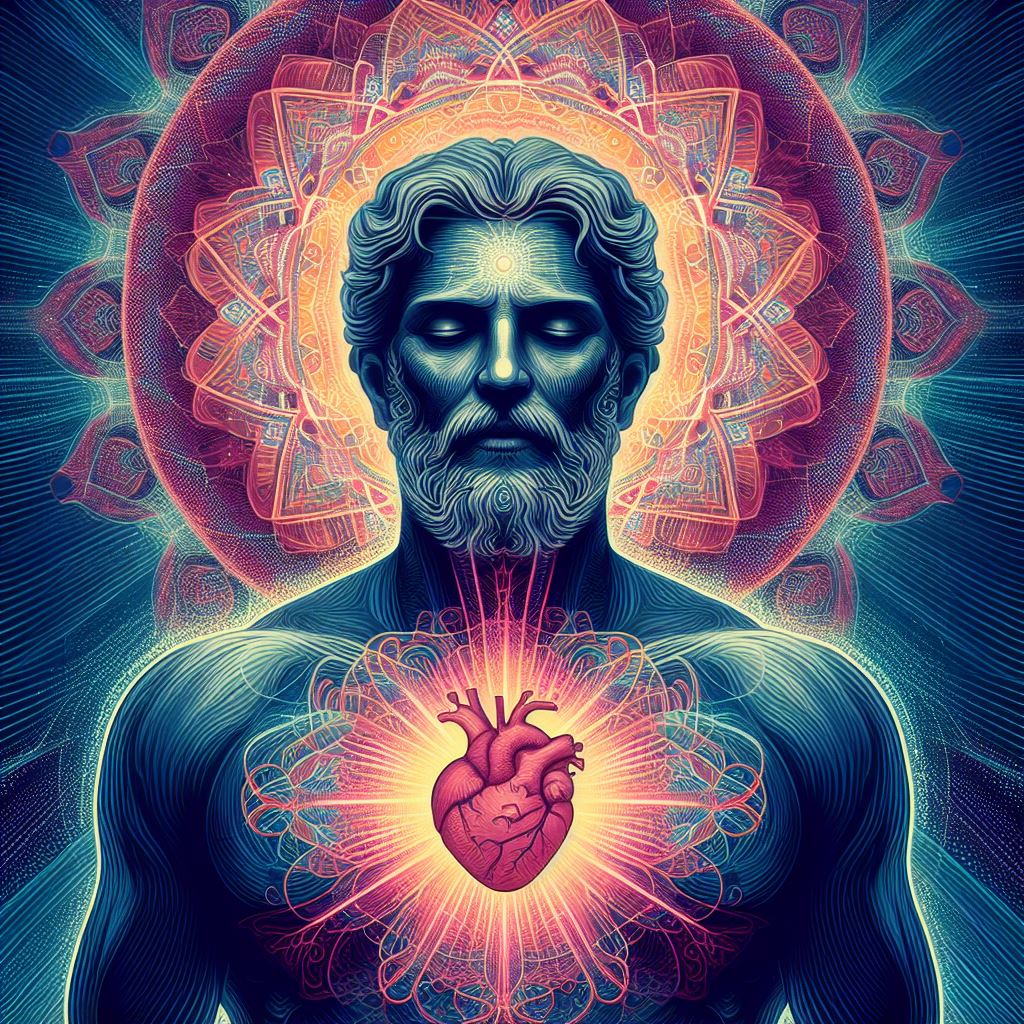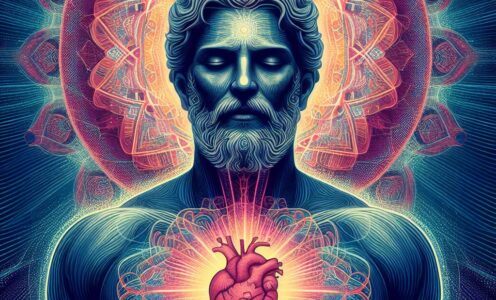We are being driven by the synthetic matrix.
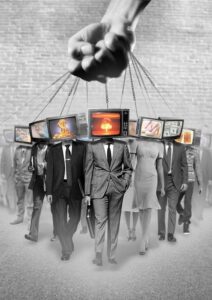
There are so many distractions in our daily lives that take us away from what really matters. If it’s not the social roles we have to fulfil, we worry about money, microbial death, or even radiation-infested flickering screens. It’s the war in the East or the war in the West. Furthermore, it is political red against political blue, or, in the same case, extrapolated to frivolous social games like football and basketball too. It is also religion against another religion. Then white against black, which then turns on yellow, and so on. Man against woman, man against man, and even woman against woman. Lately, beyond all the New World Disorder rhetoric, which is as divisive as it gets, we are being driven by the synthetic matrix into endless polarisation and division with ourselves. To cut to the chase, I’ll say this: there is nothing transcendental about the matrix or the mindset that goes with it. The only transcendence in this particular staged game is that the lie is obvious. We all know, somewhere deep inside us, that it is all sacrilegious and a lie. Hence, we feel saddened and/or angered by it all. I understand that this is a lot to take in and process on a level that goes beyond the mental. I would venture to say, and I have talked about this in a previous post, that apart from a belief in any form of divinity, our identity is the most important factor to focus on at this time, and probably always has been. To help the reader delve deeper into certain concepts that I have discussed previously, I would like to revise certain ideas, such as, the Divine Feminine, Divine Masculine and briefly touch upon certain concepts in the Vedas, as well as the Yoga Sutras. I shall also introduce to the reader the model of Neurological levels of thought of Robert Dilts, to further support some of the statements I have made previously.
Purusha & Prakriti.
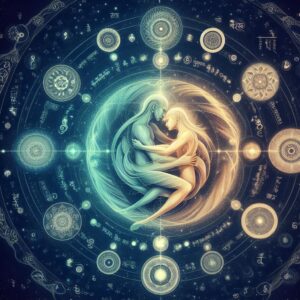
In Vedic mythology, there are two universal forces involved in the dance of the creation of life: Purusha and Prakriti. Purusha, the masculine aspect, is considered to be pure, unchanging consciousness. Nothing more or less. Purusha did not create Prakriti but came into being as a direct consequence of it. Prakriti, the feminine aspect, is all of creation itself and how it manifests through our minds, as well as our bodies, the sensory experiences, feelings, desires and emotions that come with it. Purusha & Prakriti are universal principles that are also reflected in the body-mind-soul complex of every human being on this planet. This concept of macro-micro universe is also evidenced in the bible in which it is written: As above so bellow. In reality, then, the masculine and feminine aspects of our being and of manifested reality itself, are all part of Prakriti. For the reader’s reference, in Christianity, we might compare Prakriti with the Holy Spirit. It is stated that there are countless individual Purushas, each of whom is infinite, eternal, all-knowing, immutable and unchangeable, each with their corresponding Prakriti.
Tantra and the feminine.
 Tantra by definition is what we might call a feminine path. I have said before that the path of the Goddess is chaotic, full of beauty and wonder as well as pain, doubt, sorrow and even anger. As most females of our species will tell you, it’s an intense rollercoaster ride. Firstly, it should be noted that our female counterparts are more naturally suited to this path, having more empathy and energetic awareness by biological design. Without delving into the subject of chakras and how the polarities and make up of the energetic system of the male and female of our species, I will go over some basic teachings that you will find at the core of modern Tantra. In a four-dimensional energetic model, the females of our species are energetically designed to absorb the energy of Mother Earth through the root and lift it up to the heart centre to give back to the world itself. In contrast, males are wired in the opposite direction to receive energy from the heart of the world and give it back to Mother Earth through the root. An understanding of energy and polarities is inherent in all modern Tantric and Neo-Tantric teachings. It is from this, that one can understand the relentless distortion and marketing in the modern tantric world that is based around sexual energy and sex itself. Tantra isn’t necessarily about sex, but it does require an understanding of energy at all levels of manifestation and how to work with it. Making this kind of energetic exchange with life itself, without the need for a partner, in any polarity of our choosing, is what I would call Planetary Tantra, or perhaps I could call it Skyroots Tantra myself. At the end of the path of the goddess, prerequisite to liberation, as any tantric practitioner will tell you, is surrender. Surrender of the body, mind, and soul.
Tantra by definition is what we might call a feminine path. I have said before that the path of the Goddess is chaotic, full of beauty and wonder as well as pain, doubt, sorrow and even anger. As most females of our species will tell you, it’s an intense rollercoaster ride. Firstly, it should be noted that our female counterparts are more naturally suited to this path, having more empathy and energetic awareness by biological design. Without delving into the subject of chakras and how the polarities and make up of the energetic system of the male and female of our species, I will go over some basic teachings that you will find at the core of modern Tantra. In a four-dimensional energetic model, the females of our species are energetically designed to absorb the energy of Mother Earth through the root and lift it up to the heart centre to give back to the world itself. In contrast, males are wired in the opposite direction to receive energy from the heart of the world and give it back to Mother Earth through the root. An understanding of energy and polarities is inherent in all modern Tantric and Neo-Tantric teachings. It is from this, that one can understand the relentless distortion and marketing in the modern tantric world that is based around sexual energy and sex itself. Tantra isn’t necessarily about sex, but it does require an understanding of energy at all levels of manifestation and how to work with it. Making this kind of energetic exchange with life itself, without the need for a partner, in any polarity of our choosing, is what I would call Planetary Tantra, or perhaps I could call it Skyroots Tantra myself. At the end of the path of the goddess, prerequisite to liberation, as any tantric practitioner will tell you, is surrender. Surrender of the body, mind, and soul.
Yoga and the masculine.
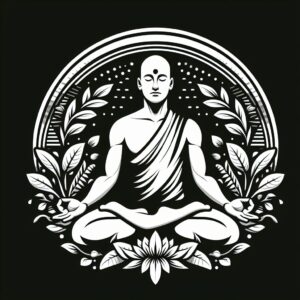
I have chosen yoga as an example of a masculine path as it is often considered the polar opposite of Tantra. I don’t exactly agree with that statement, though I understand what they mean by it. Why are most modern Yogic traditions considered a masculine path? If we look at the Yoga Sutras of Patanjali, which are an accepted reference in more modern approaches to Yoga, we can see the masculine qualities aimed for, at the heart of the Sutra’s teachings. His first statement in the first sutra, Yoga chitta vritti nirodha, explains it all. It translates as yoga removes the obstacles of the fluctuations of the mind. This statement alone implies a whole world of concepts involving how the Vedas describe the descent of the goddess into manifestation, including the different dimensions of mind and the Three Gunas. The Three Gunas are qualities of the manifestation of the mind, or three vibrations that affect the mind, to put it another way. If we were to look at the mind as a lake filled with calm and clear water, one could observe how the Three Gunas affect it in one way or another. Sattva, Rajas, and Tamas are the Sanskrit terms for these three qualities. They would be truth or goodness, activity, and finally laziness or inactivity. The optimal guna for the mind and its transcendence, according to Vedic studies and Ayurveda, is sattva, which I’ll remind the reader is truth or goodness. Suffice it to say that these three qualities are also present in all of creation, including, for example, our food choices. Tamas and Rajas are not necessarily negative qualities in food, as I’ll further explain. An Ayurvedic doctor might suggest a rajasic food to activate the system in some way. The opposite can also be true; you may need to calm someone down and give them something tamasic. To cut a long story short, the Yoga Sutras explain and outline an eight-element system for overcoming the obstacles of the mind and achieving liberation. So, without going into the eight aspects of Patanjali’s method, as this information is widely available at present, we could distill in layman’s terms: Patanjali’s eight-fold practice cultivates, above all, detachment as well as presence, and these are prerequisites to achieving liberation.
The four paths of yoga.
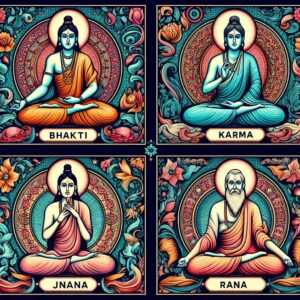 There are four paths of yoga, as traditionally classified in Indian culture. One is concerned with the right action, known as karma yoga. Another relates to devotion and is known as Bhakti Yoga. Jnana Yoga is the yoga of wisdom or knowledge and emphasizes proper education as well as self-inquiry. Finally, there is Raja Yoga, which literally means royal yoga and has to do with the control or mastery of the mind. We could surmise then that any yoga that has the Patanjali Sutras at its core is a type of Raja Yoga and implies control. Most modern day yogic disciplines that we know in the West are deeply rooted in the Yoga Sutras. Like I said earlier, Patanjali distilled the formula in his sutras down to a very fine art, and ultimately details how to cultivate the attributes needed to reconnect to the Divine Masculine. It is expressed this way because Patanjali’s method admits the feminine aspects of the path but suggests to ignore it all, until liberation is reached. Too much confusion on the way, you might say. Many well-respected gurus in India, such as Sivanada, welcomed the incorporation of all of the paths of yoga into a person’s life, obviously knowing that control of the mind isn’t enough to give us a complete understanding of it all. Devotion, right action, a cultivated mind and heart, as well as practicing detachment and focusing of the mind, are all needed, as far as I have come to understand.
There are four paths of yoga, as traditionally classified in Indian culture. One is concerned with the right action, known as karma yoga. Another relates to devotion and is known as Bhakti Yoga. Jnana Yoga is the yoga of wisdom or knowledge and emphasizes proper education as well as self-inquiry. Finally, there is Raja Yoga, which literally means royal yoga and has to do with the control or mastery of the mind. We could surmise then that any yoga that has the Patanjali Sutras at its core is a type of Raja Yoga and implies control. Most modern day yogic disciplines that we know in the West are deeply rooted in the Yoga Sutras. Like I said earlier, Patanjali distilled the formula in his sutras down to a very fine art, and ultimately details how to cultivate the attributes needed to reconnect to the Divine Masculine. It is expressed this way because Patanjali’s method admits the feminine aspects of the path but suggests to ignore it all, until liberation is reached. Too much confusion on the way, you might say. Many well-respected gurus in India, such as Sivanada, welcomed the incorporation of all of the paths of yoga into a person’s life, obviously knowing that control of the mind isn’t enough to give us a complete understanding of it all. Devotion, right action, a cultivated mind and heart, as well as practicing detachment and focusing of the mind, are all needed, as far as I have come to understand.
Why was yoga adapted by Patanjali?
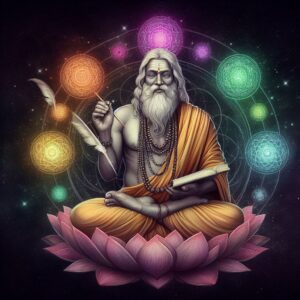 Before we go any further, I would like to address what I have come to understand during my yogic studies at WPYS in Rishikesh. It is important to know the history of what most people in the West know as yoga. What we traditionally know as yoga in western society was originally a system more in tune with the feminine aspects of existence. It is claimed by some scholars that most, if not all, yogic lineages, including Hatha Yoga, have their roots in the Tantras. Why was yoga adapted by Patanjali? Why was it adapted from a feminine or more wholesome perspective to a path with a more masculine approach? It is said that the Yoga Sutras were written around 200 BC in an effort to preserve a tradition in times of ideological and cultural adversity. This is explained by the fact that the Indian subcontinent was invaded by both the Aryans and Muslims, each at their own relevant time in history. Yoga was then redefined in a less threatening way so that the incoming invaders didn’t feel the need to destroy the yogic traditions and culture. Reportedly, this is what Patanjali did, he preserved and distilled the ancient teachings by giving them a new spin, and in the process bypassed all that would have threatened the existence of those same teachings.
Before we go any further, I would like to address what I have come to understand during my yogic studies at WPYS in Rishikesh. It is important to know the history of what most people in the West know as yoga. What we traditionally know as yoga in western society was originally a system more in tune with the feminine aspects of existence. It is claimed by some scholars that most, if not all, yogic lineages, including Hatha Yoga, have their roots in the Tantras. Why was yoga adapted by Patanjali? Why was it adapted from a feminine or more wholesome perspective to a path with a more masculine approach? It is said that the Yoga Sutras were written around 200 BC in an effort to preserve a tradition in times of ideological and cultural adversity. This is explained by the fact that the Indian subcontinent was invaded by both the Aryans and Muslims, each at their own relevant time in history. Yoga was then redefined in a less threatening way so that the incoming invaders didn’t feel the need to destroy the yogic traditions and culture. Reportedly, this is what Patanjali did, he preserved and distilled the ancient teachings by giving them a new spin, and in the process bypassed all that would have threatened the existence of those same teachings.
Dilts’ model of neurological levels of thought.
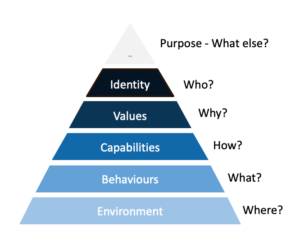
I know it might seem off topic, but I would like to briefly introduce the reader to Dilt’s model of neurological levels of thought. This pyramid model could be used to illustrate the development of the psyche, a situation, or a project. For the purposes of this article, of course, we’ll explore it in terms of the need to map the development of the human psyche. Our first point of reference for neurological levels of thought is at the base: the environment. When and where we are born makes reference to the environment as an example. Our behaviour is shaped by our responses to environmental stimuli. Our behaviour then influences the skills and abilities we may develop. Skills and abilities then shape our core beliefs and values. Self-identity is then shaped by these beliefs and values. Above all, at the top of the pyramid, is purpose. Purpose is the realm of spirituality or divinity. It is the level where the magical and unexplainable happens. To work with the neurological levels of thought, there is only one concept to grasp. To bring about change, the nuerological levels must be worked on from a level above. This means that if you wanted to facilitate a change in someone’s behaviour process, you would have to work at the level of identity, beliefs, or abilities. You cannot facilitate real change by trying to work at the same level of neurological level of thinking that you want to work on, either. That is to say, changing a belief with another would be ineffective. As stated earlier, you must always operate from a level above.
Throw every limiting concept in your energetic system into the spiritual inner fire.
 I’ve stated in a previous post that humanity is suffering from a collective dissociative disorder where we are collectively operating from a normalised, traumatised alternative personality. I also identified this collective alternative personality as the ego. We have also related in previous posts how the seven pillars of society are completely fallen and rotten, if not derelict. Government, business, media, religion, education, and even the arts and sciences have betrayed humanity. We know that we cannot trust the mainstream media to tell us the truth about current events, so why should we even assume that we really know our true history, only two to three hundred years into the recent past? We only know what we are told is the truth. Furthermore, we never really question much of what we are told. Using Dilt’s model, you can clearly see that, as a species with an identity problem, the only level at which we can operate to bring about real change is at the level of purpose. We need something greater than all the dissonance we may experience in life to sustain us and give us purpose in our unfoldment. Be prepared to throw every limiting concept in your energetic system into the spiritual inner fire. As the intention of our world society is to disconnect humanity from its sentience and from its spiritual essence, we could say that there is nothing in the matrix worth holding onto, with the possible exception of each other, our human family.
I’ve stated in a previous post that humanity is suffering from a collective dissociative disorder where we are collectively operating from a normalised, traumatised alternative personality. I also identified this collective alternative personality as the ego. We have also related in previous posts how the seven pillars of society are completely fallen and rotten, if not derelict. Government, business, media, religion, education, and even the arts and sciences have betrayed humanity. We know that we cannot trust the mainstream media to tell us the truth about current events, so why should we even assume that we really know our true history, only two to three hundred years into the recent past? We only know what we are told is the truth. Furthermore, we never really question much of what we are told. Using Dilt’s model, you can clearly see that, as a species with an identity problem, the only level at which we can operate to bring about real change is at the level of purpose. We need something greater than all the dissonance we may experience in life to sustain us and give us purpose in our unfoldment. Be prepared to throw every limiting concept in your energetic system into the spiritual inner fire. As the intention of our world society is to disconnect humanity from its sentience and from its spiritual essence, we could say that there is nothing in the matrix worth holding onto, with the possible exception of each other, our human family.
The divine masculine.
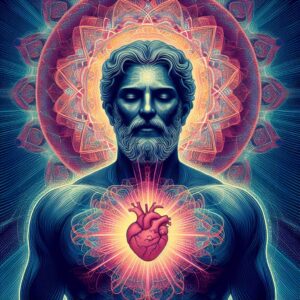
Every spiritual path, including yoga in all its variants, are essentially a feminine path. After all, everything that has come into material existence throughout all of the existing dimensions is part of the dance of Prakriti. I would state, contrary to what many believe, that in reality there is no masculine path to liberation, only attributes to aspire to and cultivate. How could there be a path? We are bringing into material existence something which has become rare and yet is unknowable and is already within everyone at the same time. Our struggles to polarise and transcend the masculine and feminine principles are in the interpretations of Prakriti. In essence, we are all the initiates of the Divine Mother and it is to her, to whom we surrender to in the latter stages of an awakening process. Surrender is perhaps the most difficult state to come to naturally, given the arduous path and all the inner and outer battles and struggles that have been won or lost along the way. Once the feminine is healed, it doesn’t easily surrender because the masculine represented within Prakriti isn’t healed. The representation that we hold of masculinity and the males of our species needs healing too. You can’t heal the Masculine principle without healing the Feminine principle first though. You are not entirely healed if the polarities are not in complete balance. In the end, we all embody these same two universal energies in our bodies. It’s not about men and women, because what we really are is the transcendence of these two polarities. That is what makes us one. Healing all aspects of the self brings about an eventual reconnection with the divine masculine. What do we do then with pure consciousness once we achieve it? What would we use it for? Seeing how we’re constantly bombarded by polarising circumstances and how polarity is obviously a powerful teacher for our species, perhaps we can consider using it to our advantage. Once we have surrendered to the mysteries of life and have managed to maintain our faith, there is really only one thing we can focus on to begin to rebuild. This is especially true if you are in or coming out of the “dark night of the soul”. There are no shades of grey in this matter. Either we are or we are not. It doesn’t get any more polarising than that, don’t you think? Use this to begin to embody your own truth. For the divine masculine to focus entirely on what or who I am, there is no higher purpose. Everything else will arise as our intrinsic nature unfolds from within and as a consequence.
I am.
You are.
We all are.
Hare Om Tat Sat.
